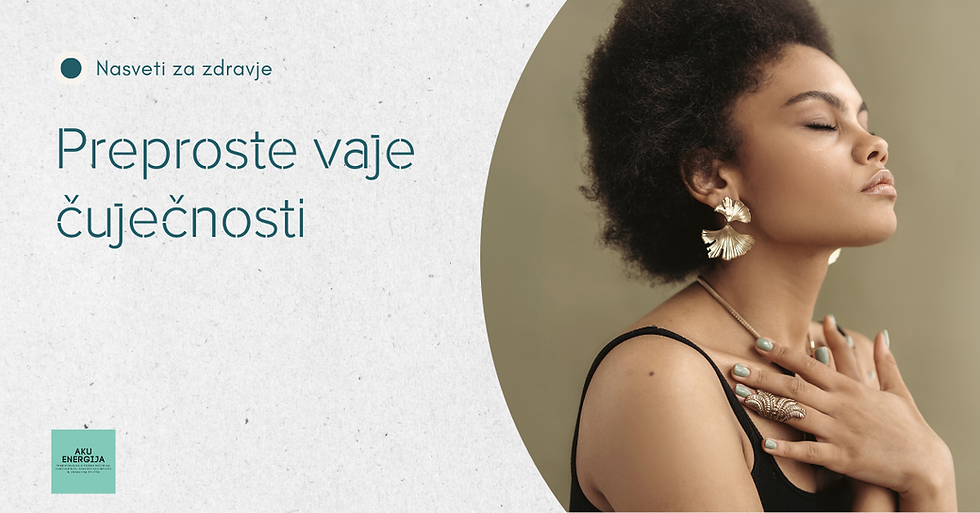Preproste vaje čuječnosti
- Aku Energija
- Sep 24, 2021
- Branje traja 6 min
Updated: Aug 3, 2023
Čuječnost spreminja naš odnos do dogodkov in izkušenj. Ustvarja prostornejši način bivanja v svetu, ki je manj reaktiven in na splošno srečnejši.
"Čuječnost je zavedanje, ki se pojavi z namensko pozornostjo, v sedanjem trenutku in brez obsojanja." Jon Kabat-Zinn, znani avtor in ustanovitelj Klinike za zmanjšanje stresa na Univerzi v Massachusettsu.
"Čuječnost je neobdelano, neobsojevalno, osredotočeno zavedanje na sedanjost, v katerem se vsaka misel, občutek, senzacija, ki se pojavi ..., prizna in sprejme takšnega, kot je." Psiholog Scott Bishop

Prednosti prakse čuječnosti
Kot nas uči taoistična modrost, veliki človek dosežka ne pripisuje sebi. Ko vadimo čuječnost, tega ne počnemo ravno zaradi njenih "koristi". To počnemo, ker je to naravno stanje našega telesa. S tem ničesar ne dodajamo ali zmanjšujemo, gre samo za to, da smo.
Seveda pa v sodobnem svetu, če ne govorimo o koristih nečesa, na to nihče niti ne bi bil pozoren.
Ko smo zavedni, z opazovanjem lastnega uma zmanjšamo stres, izboljšamo zmogljivost, pridobimo vpogled in ozaveščenost ter povečamo pozornost do dobrega počutja drugih. Meditacija čuječnosti nam v življenju daje čas, ko lahko prekinemo presojo in sprostimo svojo naravno radovednost glede delovanja uma, do svojih izkušenj pristopimo s toplino in prijaznostjo - do sebe in drugih.
Čuječnost ni vse v vaši glavi
Ko razmišljamo o čuječnosti in meditaciji, lahko razmišljamo o svojih mislih: naredili bomo nekaj glede tega, kar se nam dogaja v glavi.
Toda meditacija se začne in konča v telesu. Vzamemo si čas, smo pozorni na to, kje smo in kaj se dogaja, in to se začne z zavedanjem svojega telesa. Ta proces je lahko pomirjujoč, saj ima naše telo notranje ritme, ki so naravno mirni in sproščujoči.
Kakšni so primeri vaj čuječnosti?
Obstaja veliko preprostih načinov za vadbo čuječnosti. Nekateri primeri vključujejo:
Bodite pozorni. V zaposlenem svetu je težko upočasniti in opaziti stvari. Poskusite si vzeti čas in doživite svoje okolje z vsemi čuti - dotikom, zvokom, vidom, vonjem in okusom. Ko na primer jeste najljubšo hrano, si vzemite čas, da vonjate, okusite in resnično uživate.
Živite v trenutku. Poskusite namerno dati odprto, sprejemljivo in preudarno pozornost na vse, kar počnete. Najdite veselje v preprostih užitkih.
Sprejmite sebe. Vse "dobro" in "slabo" te ustvarjajo prav posebnega. Ni treba, da se preveč zavajate z lastno "veličino", pa tudi, da niste razočarani glede svoje šibkosti. Ohranjamo zaupanje, da premagujemo pomanjkljivosti in skromen, odprt um, da nenehno izboljšujemo svojo moč.
Osredotočite se na svoje dihanje. Ko imate negativne misli, poskusite sesti, globoko vdihniti in zapreti oči. Osredotočite se na svoj dih, ko gre v telo in iz njega. Sedenje in dihanje, pa četudi le minuto, lahko pomaga.
Poskusite lahko tudi z bolj strukturiranimi vajami čuječnosti, na primer:
Meditacija skeniranja telesa. Lezite na hrbet z iztegnjenimi nogami in rokami ob straneh, z dlanmi navzgor. Počasi in zavestno se osredotočite na vsak del telesa, od pete do glave ali glave do pete. Zavedajte se vseh občutkov, čustev ali misli, povezanih z vsakim delom vašega telesa.
Sedeča meditacija. Udobno se usedite z ravnim hrbtom, z nogami na tleh in rokami v naročju. Dihajte skozi nos, osredotočite se na dih, ki gre v in iz telesa. Če meditacijo prekinejo fizični občutki ali misli, bodite pozorni na izkušnjo in se nato ponovno osredotočite na dih.
Meditacija med hojo. Poiščite miren kraj, dolg 300 do 600 centimetrov, in začnite počasi hoditi. Osredotočite se na hojo, zavedajte se občutkov stoje in subtilnih gibov, ki ohranjajo vaše ravnotežje. Ko pridete do konca svoje poti, se obrnite in nadaljujte s hojo ter ohranite zavedanje svojih občutkov.
Kdaj in kako pogosto naj izvajam vaje čuječnosti?
Naredite to tukaj in zdaj. Obstajajo različni načini in oblike vaj čuječnosti. Najpomembnejše je, da dejansko najdete način, kako to lahko počnete redno.
Preproste vaje čuječnosti lahko izvajate kjerkoli in kadarkoli. Raziskave kažejo, da je uporaba čutil na prostem še posebej koristna.
Za bolj strukturirane vaje čuječnosti, na primer meditacijo skeniranja telesa ali meditacijo sedenja, si boste morali vzeti čas, ko ste lahko na mirnem mestu brez motenj ali prekinitev. Za to vrsto vadbe se lahko odločite zgodaj zjutraj, preden začnete z vsakodnevno rutino.
Prizadevajte si, da vsak dan vadite čuječnost približno šest mesecev. Sčasoma boste morda ugotovili, da izvajate čuječnost brez vsakega napora. Pomislite na to kot na zavezo, da se znova povežete s samim seboj in se negujete.
Simple mindfulness exercises
Mindfulness transforms how we relate to events and experiences. It creates a more spacious way of being in the world that is less reactive and generally happier.
“Mindfulness is awareness that arises through paying attention, on purpose, in the present moment, and non-judgmentally.” Jon Kabat-Zinn, well-known author and founder of the Stress Reduction Clinic at the University of Massachusetts.
“Mindfulness is a non-elaborative, nonjudgmental, present-centered awareness in which each thought, feeling, sensation that arises ... is acknowledged and accepted as it is.” Psychologist Scott Bishop
The Benefits of Mindfulness Practice
As the Taoism wisdom teaches us, the great man does not claim the achievement to his own. When we practice mindfulness exercise, we are not exactly doing it for its “benefits”. We do it because this is a natural state of our body. By doing so, we are not adding or reducing anything, it is just about being.
But of course, in the modern world, if we do not talk about the benefits of something, no one would even pay attention to it.
When we’re mindful, we reduce stress, enhance performance, gain insight and awareness through observing our own mind, and increase our attention to others’.
Mindfulness Is Not All in Your Head
When we think about mindfulness and meditation, we can get hung up on thinking about our thoughts: we’re going to do something about what’s happening in our heads.
But meditation begins and ends in the body. It involves taking the time to pay attention to where we are and what’s going on, and that starts with being aware of our body. This process can be calming, since our body has internal rhythms which are naturally calm and relaxing.
What are some examples of mindfulness exercises?
There are many simple ways to practice mindfulness. Some examples include:
Pay attention. It's hard to slow down and notice things in a busy world. Try to take the time to experience your environment with all of your senses — touch, sound, sight, smell and taste. For example, when you eat a favorite food, take the time to smell, taste and truly enjoy it.
Live in the moment. Try to intentionally bring an open, accepting and discerning attention to everything you do. Find joy in simple pleasures.
Accept yourself. All the “good” and “bad” create the very special you. No need to be too self-absorbing how your own “greatness” but also not to be frustrated about your weakness. We keep our confidence to overcome the shortcomings and a humble, open mind to continuously improve our strength.
Focus on your breathing. When you have negative thoughts, try to sit down, take a deep breath and close your eyes. Focus on your breath as it moves in and out of your body. Sitting and breathing for even just a minute can help.
You can also try more structured mindfulness exercises, such as:
Body scan meditation. Lie on your back with your legs extended and arms at your sides, palms facing up. Focus your attention slowly and deliberately on each part of your body, in order, from toe to head or head to toe. Be aware of any sensations, emotions or thoughts associated with each part of your body.
Sitting meditation. Sit comfortably with your back straight, feet flat on the floor and hands in your lap. Breathing through your nose, focus on your breath moving in and out of your body. If physical sensations or thoughts interrupt your meditation, note the experience and then return your focus to your breath.
Walking meditation. Find a quiet place 10 to 20 feet in length, and begin to walk slowly. Focus on the experience of walking, being aware of the sensations of standing and the subtle movements that keep your balance. When you reach the end of your path, turn and continue walking, maintaining awareness of your sensations.
When and how often should I practice mindfulness exercises?
Just do it, here and now. There are different ways and forms of mindfulness exercises. The most important thing is that you actually find a way that you can do it regularly.
Simple mindfulness exercises can be practiced anywhere and anytime. Research indicates that engaging your senses outdoors is especially beneficial.
For more structured mindfulness exercises, such as body scan meditation or sitting meditation, you'll need to set aside time when you can be in a quiet place without distractions or interruptions. You might choose to practice this type of exercise early in the morning before you begin your daily routine.
Aim to practice mindfulness every day for about six months. Over time, you might find that mindfulness becomes effortless. Think of it as a commitment to reconnecting with and nurturing yourself.







Komentarji